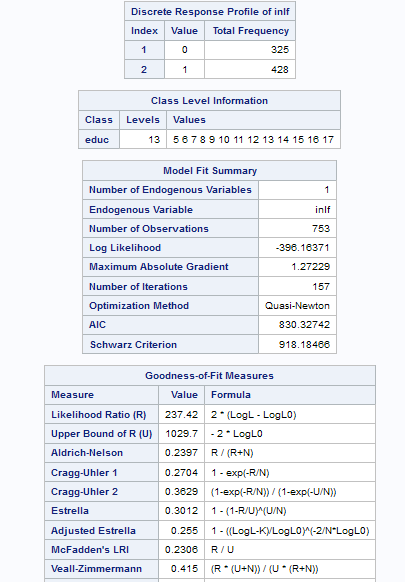Binary Probit/Logit Regression Task
About the Binary Probit/Logit Regression Task
The Binary Probit/Logit Regression task performs a regression analysis of a binary dependent variable from normal or logistic distributed panel data.
Note: Your site must license SAS/ETS
to use this task. The version of the task depends on what version
of SAS/ETS is available at your site. For example, if your site is
running the second maintenance release for SAS 9.3, SAS/ETS 12.1 is
available, and SAS Studio is running version 1 of the Binary Probit/Logit
Regression task. If your site is running SAS 9.4, SAS/ETS 12.3 or
later is available, and SAS Studio is running version 2 of the Binary
Probit/Logit Regression task. The difference between the two versions
is the addition of new options in SAS/ETS 12.3 or later.
Assigning Data to Roles
To run the Binary Probit/Logit
Regression task, you must assign a column to the Dependent
variable role.
|
Role
|
Description
|
|---|---|
|
Dependent
variable
|
specifies the numeric column to use as the dependent variable for the regression analysis.
Use the Distribution drop-down
list to specify whether to create a normal or logistic model.
|
|
Continuous
variables
|
specifies the numeric columns to use as the independent regressor (explanatory) variables for the regression model.
|
|
Categorical
variables
|
specifies how to group
values into levels.
|
Setting Options
|
Option
|
Description
|
|---|---|
|
Methods
|
|
|
Type of
covariances of the parameter estimates
|
specifies the type of covariance matrix of the parameter estimates.
You can specify these
types of matrices:
|
|
Include
the intercept in the model
|
specifies whether to include the intercept in the model.
|
|
Heteroscedasticity
|
|
|
Analyze
heteroscedasticity
|
displays the heteroscedasticity options.
|
|
Variables
on the variance function
|
|
|
Form of
variance function
|
specifies the link function to use. You can choose from these options:
|
|
Optimization
|
|
|
Method
|
specifies the iterative
minimization method to use. By default, the Quasi-Newton method is
used.
|
|
Maximum
number of iterations
|
specifies the maximum number of iterations for the selected method.
|
|
Statistics
|
|
|
You can specify whether
to include any statistics in the results.
Here is the information
that you can choose to include in the results:
|
|
|
Plots
|
|
|
Select plots
to display
|
specifies whether to display the default plots created by the task, only the plots that you select, or no plots.
|
|
Diagnostic Plots
|
|
|
Error standard
deviations by observed regressor
|
displays the error standard deviation versus observed regressors when you assign a column to the Variables
on the variance function option.
|
|
Profiled
log likelihood
|
displays the profiled log likelihood. Each profiled graph is obtained by setting all the parameters to their maximum likelihood estimate except for the profiling parameter. The profiling parameter takes values on a predefined
grid that is determined by
the maximum likelihood estimate of the corresponding standard deviation.
|
|
Output Plots
|
|
|
Predicted
values by regressor
|
displays the model predicted values. Each contributing regressor is set equal to its mean, except for the parameter that is reported on the X axis.
|
|
Marginal
effects by regressor
|
displays the marginal effects. Each contributing regressor is set equal to its mean,
except for the parameter that is reported on the X axis.
|
|
Inverse
Mills ratio by regressor
|
displays the inverse Mills ratio. Each contributing regressor is set equal to its
mean, except for the parameter that is reported on the X axis.
|
|
Predicted
response probability by regressor
|
displays the predicted response probability. Each contributing regressor is set equal to its mean, except for the
parameter that is reported on the X axis.
|
|
Predicted
probabilities for each level of the response by regressor
|
displays the predicted probabilities for each level of the response. Each contributing regressor is set equal to its mean,
except for the parameter that is reported on the X axis.
|
|
Linear predictor
values by regressor
|
displays the structural part on the right side of the model. Each contributing regressor
is set equal to its mean, except for the parameter that is reported on the X axis.
|
|
Display
as
|
specifies whether to display the plots in a panel or individually.
|
Copyright © SAS Institute Inc. All rights reserved.






